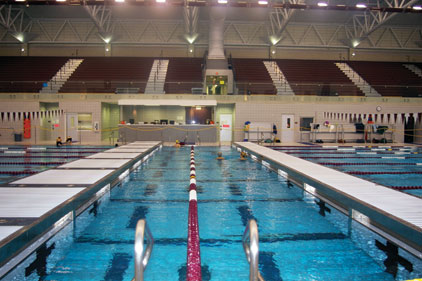
|
|
The 50,000-square-foot Jenks Trojan Aquatic Center in Jenks, Okla., used recovery dehumidification systems, along with other ventilation systems, to reduce respiratory issues common with indoor pools. |
If the space doesn’t have proper air quality or ventilation, swimmers can be breathing in bacteria or chlorine.
A new $19 million high school natatorium is successfully eliminating the problem with its HVAC design.
The new 50,000-square-foot Jenks Trojan Aquatic Center in the small Tulsa, Okla., suburb of Jenks, passed its first major IAQ test in March. The center hosted 626 swimmers, 80 coaches, 60 volunteers, 30 referees and more than 1,000 spectators at the Speedo Championship Series central zone senior sectionals competition.
The meet’s USA Swimming referee and the 2012 central zone chairman, Stephen Potter, surveyed 100 participants on the center’s IAQ conditions and recorded a 3.9 rating (on a scale of one to four).
According to the organizers of the event, it was by far the highest recorded air-quality rating in the last 10 major meets held in the seven-state region’s premier venues. The 2008 national championships in Minnesota were set back by swimmer breathing challenges, Potter said, so the region’s swimmers are already attuned to air-quality conditions.
“Venues struggling with air quality should make a trip to Jenks to see their unique setup and the facility should be strongly considered for the next available central zone or sectional championships,” said Potter, a 45-year veteran of swimming competitions.
Custom installation
The IAQ project was led by Ben Ferem, Jenks Public Schools’ district executive administrator, and Mark Bragg, principal with KSQ Architects in Tulsa. The team also had the help of pool consultants and manufacturer representatives.
The project specified two custom-manufactured Seresco NE Series 64-ton energy recovery dehumidification systems combined with one of the first applications of a new chloramines source capture and exhaust system manufactured by Paddock Pool Equipment.
The Seresco units heat or cool the space to 82°F and dehumidify to 55 percent relative humidity. The dehumidifiers’ heat-recovery capability also offers the opportunity to integrate free 80°F pool water heating in the future.
Besides the IAQ benefit of maintaining tight relative humidity and temperature control, the units also save operating costs through energy efficiency. Installed by the project’s mechanical contractor, Mechanical Air Systems Inc., each 46,500-cubic-feet-per-minute unit recovers compressor heat for pool water heating. They also use energy-saving direct-drive plenum fans with variable-frequency drive control. On days with ideal outdoor conditions, the system also shifts into economy mode for additional energy savings.
Indoor air comfort and system operation is streamlined with WebSentry, Seresco’s proprietary factory-based 24/7 remote monitoring and control service that communicates with each unit’s command center via the Internet. The WebSentry connection to the aquatic center’s dehumidifiers command center systems allows factory technicians or authorized service technicians to monitor and control more than 100 operating parameters, including real-time refrigerant pressures.
Unit operation, monitored daily by the factory, can detect operating trends or component failures that might affect the HVAC conditions in the natatorium. In the event of a performance alarm, the unit sends notifying emails to authorized Jenks employees. The vital statistics, and especially recorded trending information, gives Seresco factory technicians enough details to help support local HVAC service technicians on any issue that arises.
Reducing chloramines
Even in perfect environments of proper ventilation, temperature and humidity, chlorine molecules attach to ammonia and other organic substances introduced by swimmers resulting in a heavy, noxious gas that congregates at the water’s surface, causing respiratory irritations.
Natatorium ventilation design strategies typically direct supply air toward the perimeter and down to breathing zones at the deck surface. The ventilation specification adds Paddock’s new Evacuator, a chloramines source capture and exhaust plenum-type of device integrated into one width of the pool gutter system that draws and exhausts chloramines directly off the pool surface.
Equally important is positioning the chloramines source capture and exhaust system at the pool edge nearest the natatorium’s return-air grille, which helps draw chloramines toward the evacuation system. Pool builder KC Gunite Inc. installed the 174- by 75-foot pool, the pool equipment, gutter system, and the chloramines source capture and exhaust system.
Even though chloramine reduction will extend the facility’s lifecycle longer than most indoor pools, KSQ Architects’ design team, led by Mark Bragg, still chose materials that would withstand the sometimes-hostile environments of natatoriums. For example, the entire pool surface is tiled instead of plastered. And many square feet of wall surface use Kerlite porcelain wall coverings that resist corrosion and coordinate with the pool tile texture.
SHW Group’s ventilation design also maintains a comfortable environment in the 1,200-seat spectator section. The dehumidifiers condition the area for typical daily use, but in the event of heavily attended swimming meets, the HVAC system also activates an Aaon conventional makeup-air package unit that functions as a backup to ensure temperature or carbon dioxide target levels are maintained during full occupancy.
Another integral part of the ventilation design is the Sedona-Xm textile HVAC duct, which has an anti-microbial agent built into the material to minimize contaminants that can occur in metal ductwork. Manufactured by DuctSox, the main pool area has four runs of 54-inch-diameter duct each with two airflow devices for adjusting air distribution inside the duct.
With a heavily attended meet such as the Speedo Championships, the aquatic center showed how a natatorium retrofit can confront IAQ and ventilation issues. George Villarreal, a center manager, saw first-hand how successful the indoor environment was during the meet.
“The IAQ was the best I’ve ever seen at a major swimming competition,” he said. “There were no signs of coughing, burning eyes and the environment was comfortable for swimmers and spectators alike.”


Report Abusive Comment